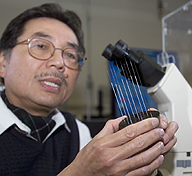Research
Highlights...
|
|
Berkeley Lab's
Jay Keasling |
|
 |
| Number 163 |
July 26, 2004 |
Mutated organisms may hold key to hydrogen production
Researchers at the National Renewable Energy Laboratory are working on a novel way to use green algae to produce hydrogen directly from water and sunlight. Green alga produces oxygen during photosynthesis but oxygen inhibits the function of algal hydrogenase, the enzyme that allows the release of hydrogen gas. Under normal conditions such as sunlight, the alga cannot sustain hydrogen production for more than a few minutes. NREL researchers are addressing this issue by screening for naturally occurring organisms that are more oxygen tolerant and by creating new genetic organisms that can sustain hydrogen production in the presence of oxygen. Further research will determine if the modified enzymes will lead to the most-cost-effective, efficient route to hydrogen.
[Sarah Holmes Barba, 303/275-3023;
sarah_barba@nrel.gov]
|
|
Forgotten research leaps to the fore
When LLNL physicist Dmitri Ryutov gave a talk on the upper-bound estimate of a finite photon mass in 1996, he never thought it would have implications eight years later. But to his surprise, his paper "The Role of Finite Photon Mass in Magnetohydrodynamics of Space Plasmas," that appeared in a plasma physics journal in 1997, has recently piqued the interest of particle physicists and astrophysicists worldwide. Ryutov's estimate has been selected to appear in the 2004 edition of the “Review of Particle Physics,” a bi-annual authoritative compendium of particle data, as the best estimate of photon mass to date. “I had already forgotten about all of this until I got the notice,” Ryutov said. “This opens up the whole review of the best estimate of photon mass. The only way to know is to improve the estimate.” Photon mass is assumed to be zero, but physicists have been trying for years to figure out how small the mass actually is. The finite-mass photon is perfectly compatible with Einstein's relativity theory. Ryutov suggested an upper-bound estimate based on observations of the solar wind: the photon mass is less than the electron mass divided by 10 billion of trillions.
[Anne M. Stark, 925-422-9799;
stark8@llnl.gov]
|
|
Nanoprobe boosts ability to detect
|
Tuan Vo-Dinh expects big things from the nanoprobe. |
The ability to detect chemicals, explosives, drugs and other substances of interest has been enhanced by a detection technology developed by a team at DOE's Oak Ridge National Laboratory. The nanoprobe is an optical fiber tapered to a tip measuring 100 nanometers with an extremely thin coating of nanoparticles of silver, which induces the surface-enhanced Raman scattering (SERS) effect. The resulting probe, based on the SERS light scattering technique, can detect substances at a theoretical single-molecule level without sample preparation and on any surface. The nanoprobe is far more selective and accurate than conventional competing technologies.
[Ron Walli, 865/576-0226;
wallira@ornl.gov]
|
|
Computer code can help build better fluidized beds
A computer program known as MFIX (Multiphase Flow with Interphase eXchanges), developed at DOE's National Energy Technology Laboratory, helps scientists, engineers, and utility and industrial plant designers better understand the workings of fluidized-bed combustion systems, eventually allowing them to operate fossil-fueled systems under a wider range of conditions, and easing the painful task of moving fluidized-bed technologies from pilot-plant size to large, commercial plants. By trying to capture a fluidized bed’s physical behavior, scientists end up with a large set of complicated mathematical equations. MFIX solves these equations with a computer code that can generate their numerical solutions. These must then be interpreted. One method of interpretation is to create graphics, allowing scientists to visualize the inner workings of fluidized beds. Scientists can then “see” the fluid dynamics of flue gases that typically contain a lot of solid particles.
[Otis Mills, Jr., 412/386-5890;
mills@netl.doe.gov]
|
|
|
|
Berkeley Lab's Jay Keasling: From bugs to drugs
|
Berkeley Lab's Jay Keasling with sweet wormwood, the plant that produces the most effective anti-malarial. |
Google "synthetic biology" and the first page brings up the world's first synthetic biology department, just a year old and chaired by Jay Keasling of Lawrence Berkeley National Laboratory's Physical Biosciences Division.
"I've been interested in synthetic biology ever since I got interested in biology," says Keasling, who's also a professor of chemical engineering at the University of California at Berkeley. Keasling's molecular-biology courses while a premed student at the University of Nebraska suggested that life could be engineered "to solve problems that cannot be solved in any other way."
A Ph.D. in chemical engineering from the University of Michigan and a postdoctoral stint in Arthur Kornberg's lab at Stanford equipped him with some of the necessary tools. His team has already made substantial progress with a project that combines bioengineering and Keasling's desire to help humanity: curing malaria, which annually kills millions, mostly children.
The most effective and expensive malaria drug is plant-derived artemisinin. "By inserting genes from three separate organisms into Escherichia coli, we're creating a bacterial strain that can produce the artemisinin precursor, amorphadiene." Production has been increased by many orders of magnitude, but the process isn't complete.
"We are now attempting to clone the remaining genes needed for the E. coli to produce artemisinin," Keasling says. "We've taken the engineering of a microbe about as far as anyone has at this point, but so far it's like building a radio with vacuum tubes. We need to be at the Pentium chip stage."
A new world of designer molecules awaits. Terpenoids, of which artemisinin is one, include promising drugs like cancer-fighting Eleutherobin, extracted from a rare form of marine coral, and anti-HIV Prostratin. "And there are many more beneficial things that can be done with E. coli and other microbes," says Keasling, "from orphan drugs to environmental clean-up."
Submitted by DOE's
Lawrence Berkeley
National Laboratory
|
|




